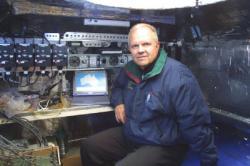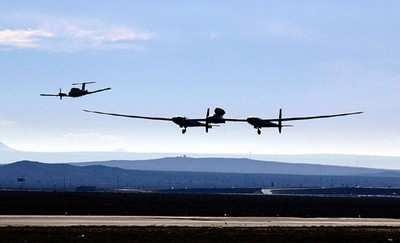That Caused The Leak That Almost Stopped GlobalFlyer
Say, where DID that fuel go -- you know, the 2,600 pounds of
Jet-A that went missing during Steve Fossett's successful attempt
to fly solo and unrefueled around the world?
Fossett said it went right out the fuel vents.

The adventurer-pilot told reporters on a conference call Tuesday
afternoon, remembering the fuel shortage that almost cost him the
world record on his 67 hour-long flight from Salina, KS, to...
Salina, KS aboard the Virgin Atlantic GlobalFlyer.
"We were having some problems with our fuel gauges," he said
during the conference call, which was arranged by EAA to announce
that Fossett and the GlobalFlyer will be at AirVenture 2005.
"We thought, at first, that it was just a gauge problem. But as we
tracked the fuel through the first half of the flight, we realized
it was much more serious than that. Fuel was missing."
 The fuel is no longer missing, said
Fossett. He knows exactly where it went -- right out of the fuel
vents sometime during the first half of his global flight.
As ANN reported in real time during the record
attempt, Fossett lost about 2,600 pounds of the 18,100 pounds in
fuel on board at take-off. All of the missing fuel apparently
sloshed out of the vents.
The fuel is no longer missing, said
Fossett. He knows exactly where it went -- right out of the fuel
vents sometime during the first half of his global flight.
As ANN reported in real time during the record
attempt, Fossett lost about 2,600 pounds of the 18,100 pounds in
fuel on board at take-off. All of the missing fuel apparently
sloshed out of the vents.
"We have determined, in conjunction with the engineers, that it
was an error in the placement of the fuel vents. Fuel vents
normally go right on top of the tank that you want to vent. My main
tanks are these big boom tanks."
But, Fossett said, that wouldn't work for GlobalFlyer because of
the drag such placement would generate. "The fuel vents, instead,
were put on the central fuselage, on the engine cowling. The
trouble was, when the airplane was full of fuel, there's solid fuel
in between the booms and the main fuselage. So as the air expanded
in the boom tanks, as I climbed in altitude, it had the effect of
forcing fuel out the vents instead of air."
Other Than That, Mrs. Lincoln, How Was The Play?
Other than worrying about the fuel problem, Fossett said he had
to be concerned about the vast difference between his take-off and
landing weights.
"The engineers at Scaled Composites warned me about how
horrendous these handling qualities would be and how much the
airplane would change. I actually was very pleasantly surprised,"
he said. "Of course, the airplane was heavier-handling at take-off,
but it was entirely manageable. Then, flying at the light weights,
coming in for landing, it's a little bit touchy, but still entirely
manageable. I felt the problems of handling were perhaps
exaggerated -- perhaps I was over-warned on those."
What do you do for 67 hours in a cockpit less than eight feet
long? You spend a lot of time managing the fuel system in order to
maintain proper CG.
"The engineers at Scaled Composites were advising me on when and
where to shift fuel during the flight."

Perhaps the most personally moving part of the flight, Fossett
said, was near the end of the historic mission, when he started
hearing congratulatory messages from other pilots on his flight
center frequency.
"Initially, as I was flying over the western states, [the other
pilots] wanted to know where the GlobalFlyer was and asking for
permission to fly closer," Fossett told reporters Tuesday. "The
airlines were wanting to show the passengers the airplane.... But
as I was approaching, it was very interesting that pilots were
getting on air traffic control, congratulating me on behalf of
their airline. There must've been 20 of those calls in rapid
succession."
What's next for Fossett and Flyer? The millionaire-adventurer
said he has several projects in the works -- some having to do with
aviation -- but wouldn't elaborate. He did say he plans to donate
the Virgin Atlantic GlobalFlyer to the Steven Udvar-Hazey Annex at
the Smithsonian's Air and Space Museum. "I may have some additional
program that I want to do after Oshkosh, before I put it in the
museum," he said. But that'll be another story.
 ANN's Daily Aero-Linx (05.06.25)
ANN's Daily Aero-Linx (05.06.25) ANN's Daily Aero-Term (05.06.25): Ultrahigh Frequency (UHF)
ANN's Daily Aero-Term (05.06.25): Ultrahigh Frequency (UHF) ANN FAQ: Q&A 101
ANN FAQ: Q&A 101 Classic Aero-TV: Virtual Reality Painting--PPG Leverages Technology for Training
Classic Aero-TV: Virtual Reality Painting--PPG Leverages Technology for Training Airborne 05.02.25: Joby Crewed Milestone, Diamond Club, Canadian Pilot Insurance
Airborne 05.02.25: Joby Crewed Milestone, Diamond Club, Canadian Pilot Insurance





